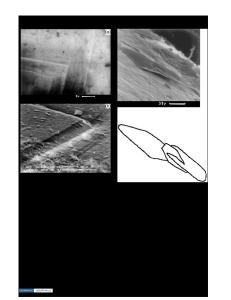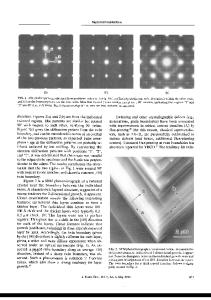Thermal instability of (Bi,Pb) 2 Sr 2 Ca 2 Cu 3 O x in contact with silver
- PDF / 1,026,054 Bytes
- 13 Pages / 612 x 792 pts (letter) Page_size
- 63 Downloads / 319 Views
MATERIALS RESEARCH
Welcome
Comments
Help
Thermal instability of (Bi,Pb)2 Sr2 Ca2 Cu3 Ox in contact with silver Robert J. Moon, Kevin P. Trumble, and Keith J. Bowman School of Materials Engineering, Purdue University, West Lafayette, Indiana 47907 (Received 18 February 1998; accepted 21 August 1998)
The chemical and microstructural evolution of particulate (Bi,Pb)2223 in contact with pure bulk silver at 830 to 905 ±C under flowing air and Ar–5% O2 atmospheres has been studied. Specimens annealed under PO2 and temperature conditions for which the (Bi,Pb)2223 phase itself is stable, based on a critical assessment of the literature, revealed a silver/(Bi,Pb)2223 interface-limited reaction, producing both solid and liquid decomposition phases. The (Bi,Pb)2223 not in direct contact with silver exhibited no reaction under the same conditions. Solid silver dissolves into the (Bi,Pb)2223 incongruent liquid, facilitating the incongruent melting reaction. On cooling, equiaxed metallic silver particles precipitated uniformly throughout bulk specimens partially melted on a silver substrate.
I. INTRODUCTION
The thermochemical stability of bismuth strontium calcium cuprates Bi2 Sr2 Can21 Cun Os412nd with n 1 (2201 phase), n 2 (2212 phase), or n 3 (2223 phase) is complicated and not well understood.1,2 The complex crystal structures and large differences in stability of the constituent oxides probably limit the ranges of temperature and PO2 over which these phases are stable. Determining the stability ranges of the BSCCO phases has been difficult due to unresolved influences of stoichiometry.1,3 Routine additions of lead to facilitate 2223 phase formation further increases the complexity of the system.4–7 Moreover, practical processing of BSCCO usually involves direct contact of BSCCO phases with silver. Silver is primarily used with BSCCO in the powderin-tube (PIT) method of forming composite wires and tapes because it has no adverse effects on Jc or Tc of the oxide phases8 and enhances mechanical integrity. The PIT processing method typically uses partially calcined 2212–rich multiphase powder, which is inserted into a silver tube, drawn to the desired diameter, rolled into tapes, and thermomechanically processed. The thermomechanical processing includes multiple deformation and sintering cycles that promote the formation, increase the texturing, and enhance the grain growth of the 2223 phase.8–11 The formation of the 2223 phase from the 2212-rich powder is believed to involve a liquid phase.12–15 Several authors have shown that 2223 nucleates at, and grows preferentially along, the silver/2212 interface.16–19 Most studies have focused attention on how silver affects the rate of (Bi,Pb)2223 phase formation from precursors rather than the microstructural evo-
652
http://journals.cambridge.org
J. Mater. Res., Vol. 14, No. 3, Mar 1999
Downloaded: 04 Apr 2015
lution of preformed (Bi,Pb)2223 within silver-bearing (Bi,Pb)2223 specimens. The preferential formation of the (Bi,Pb)2223 phase at the silver/2212 phase inte
Data Loading...











